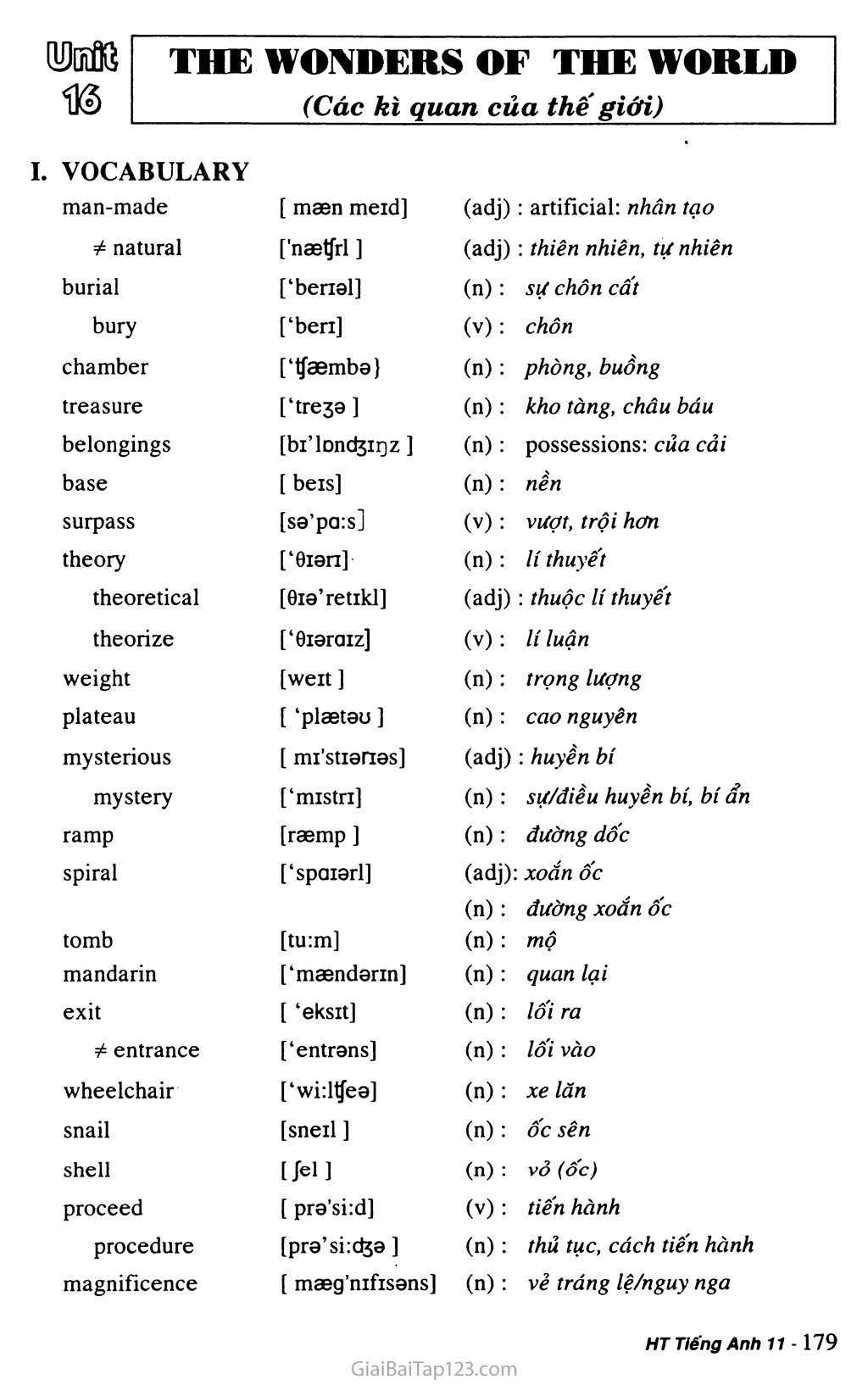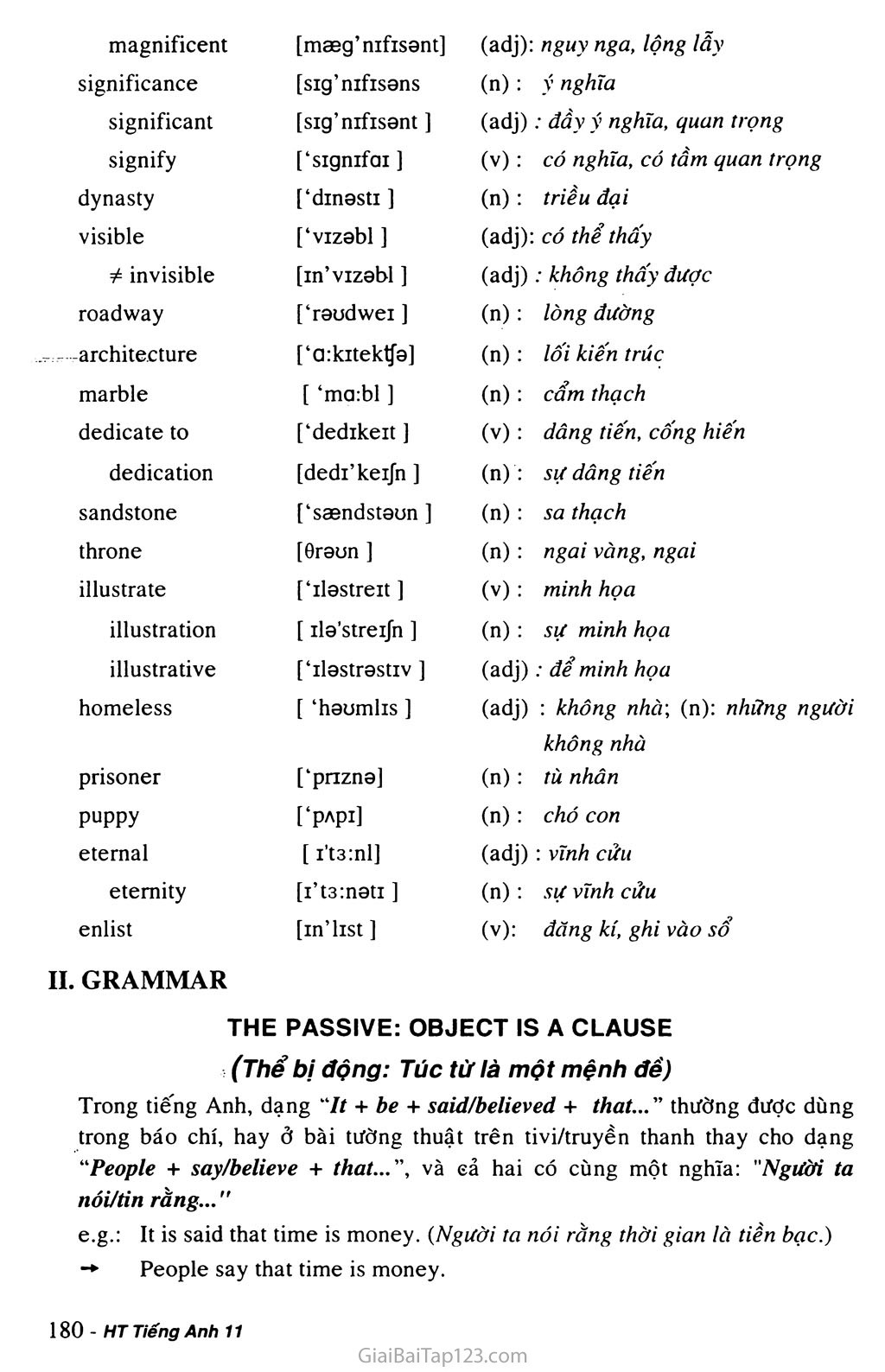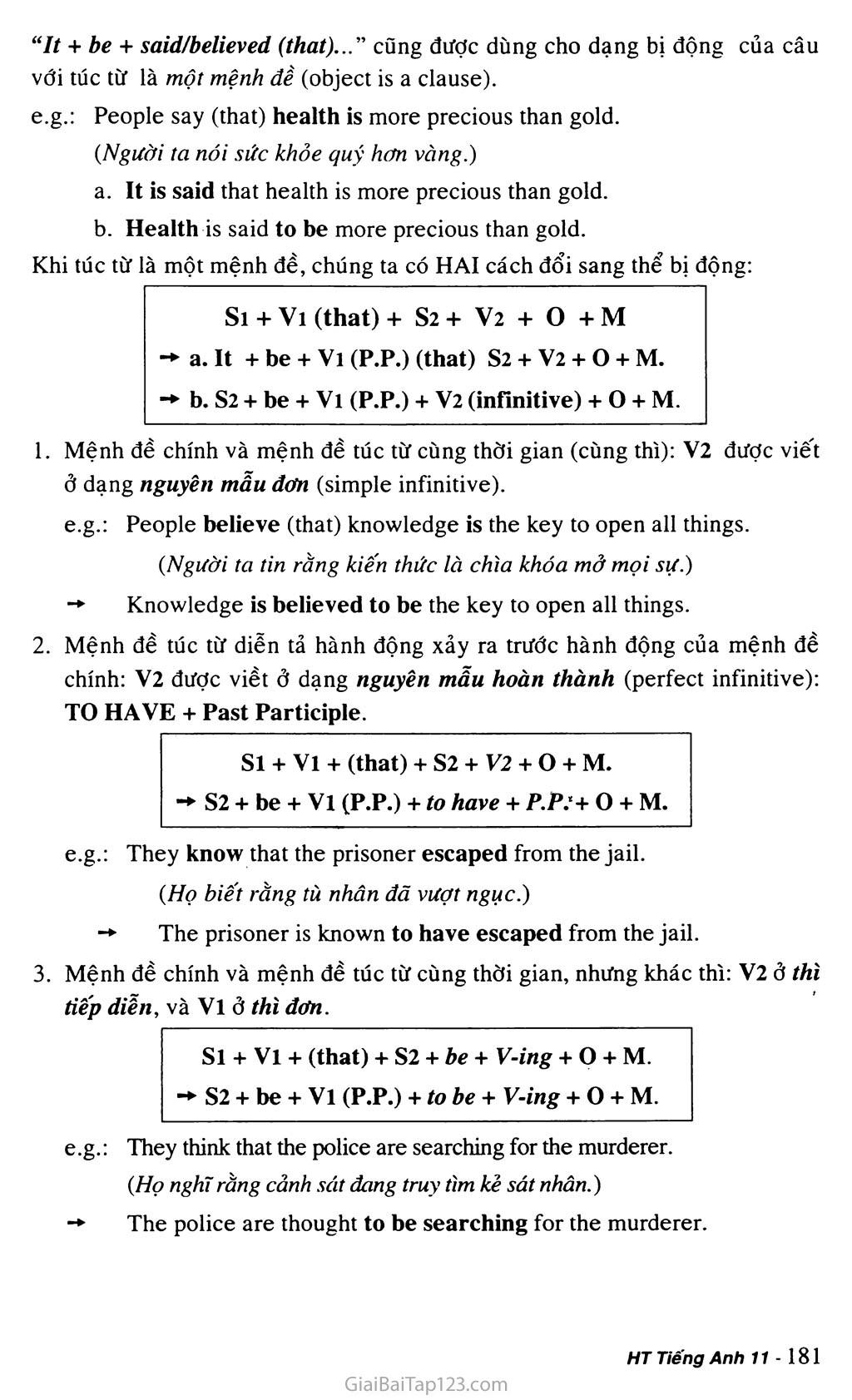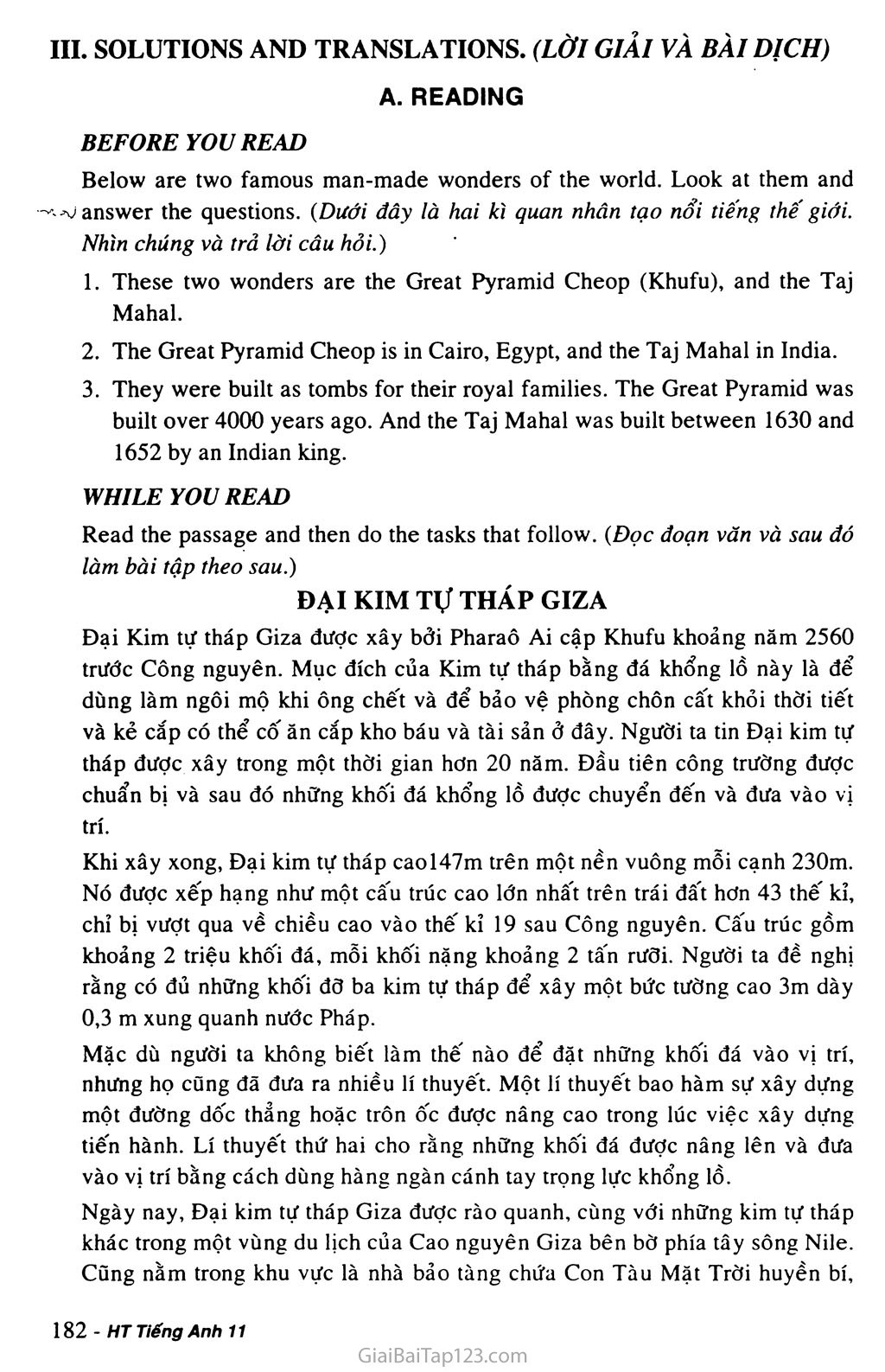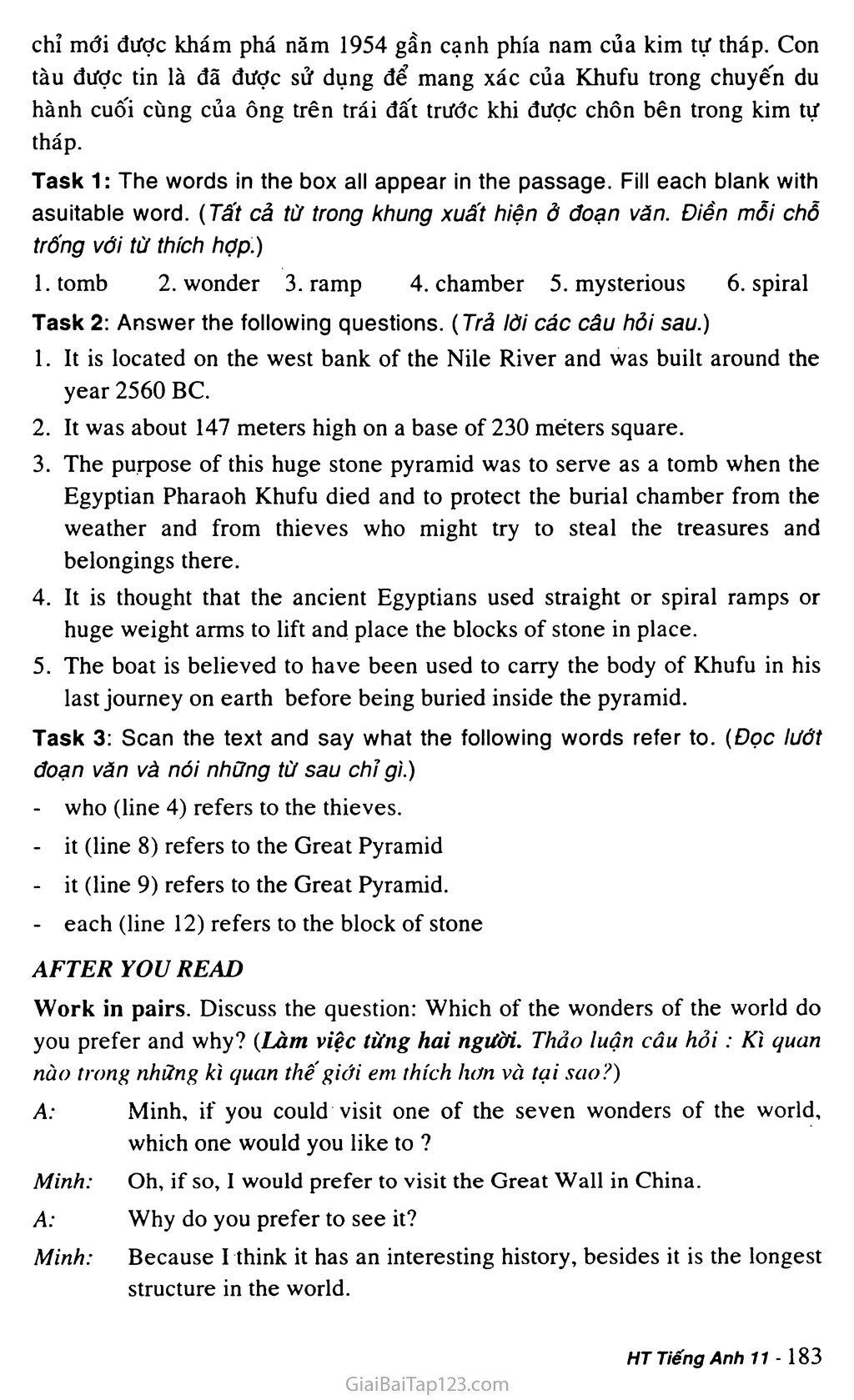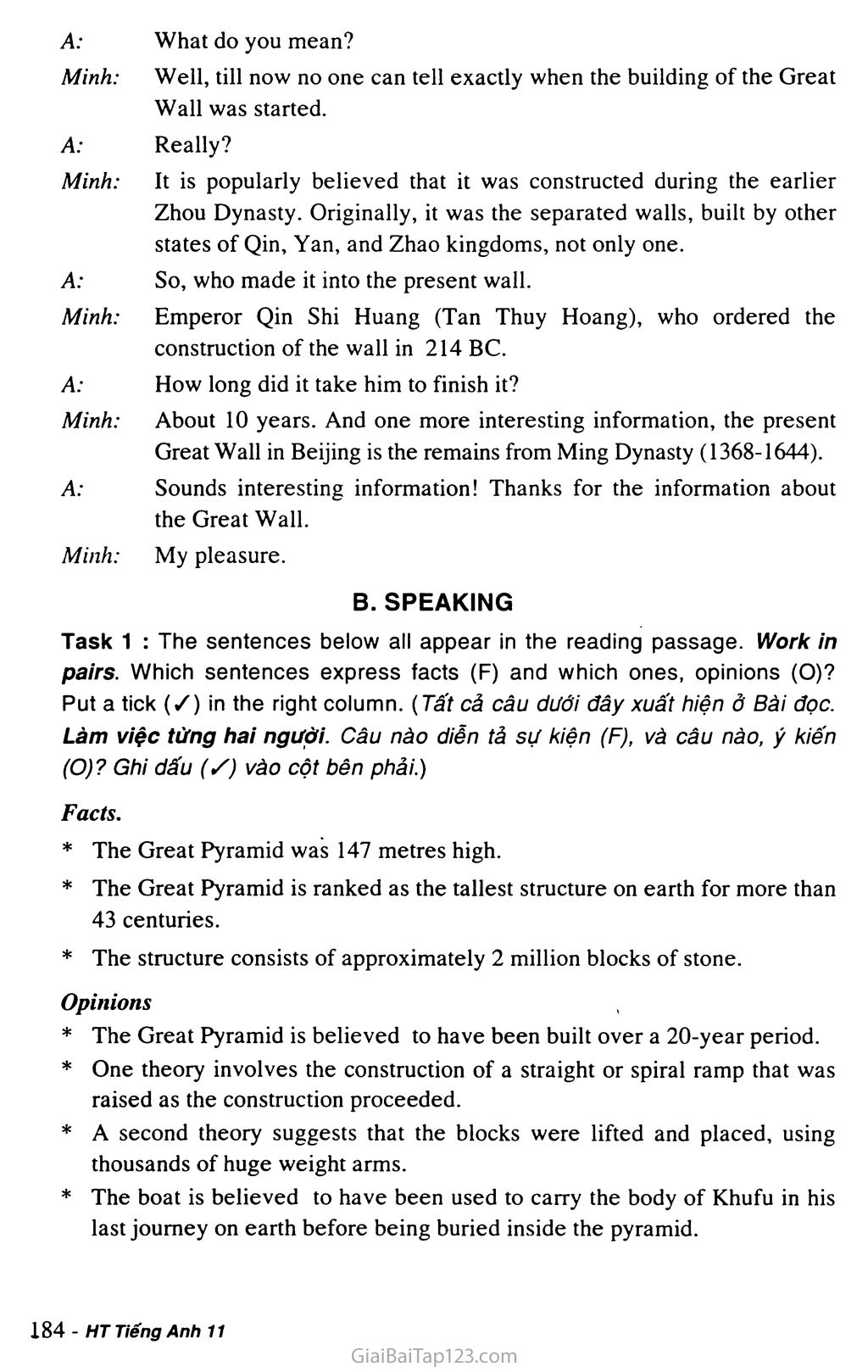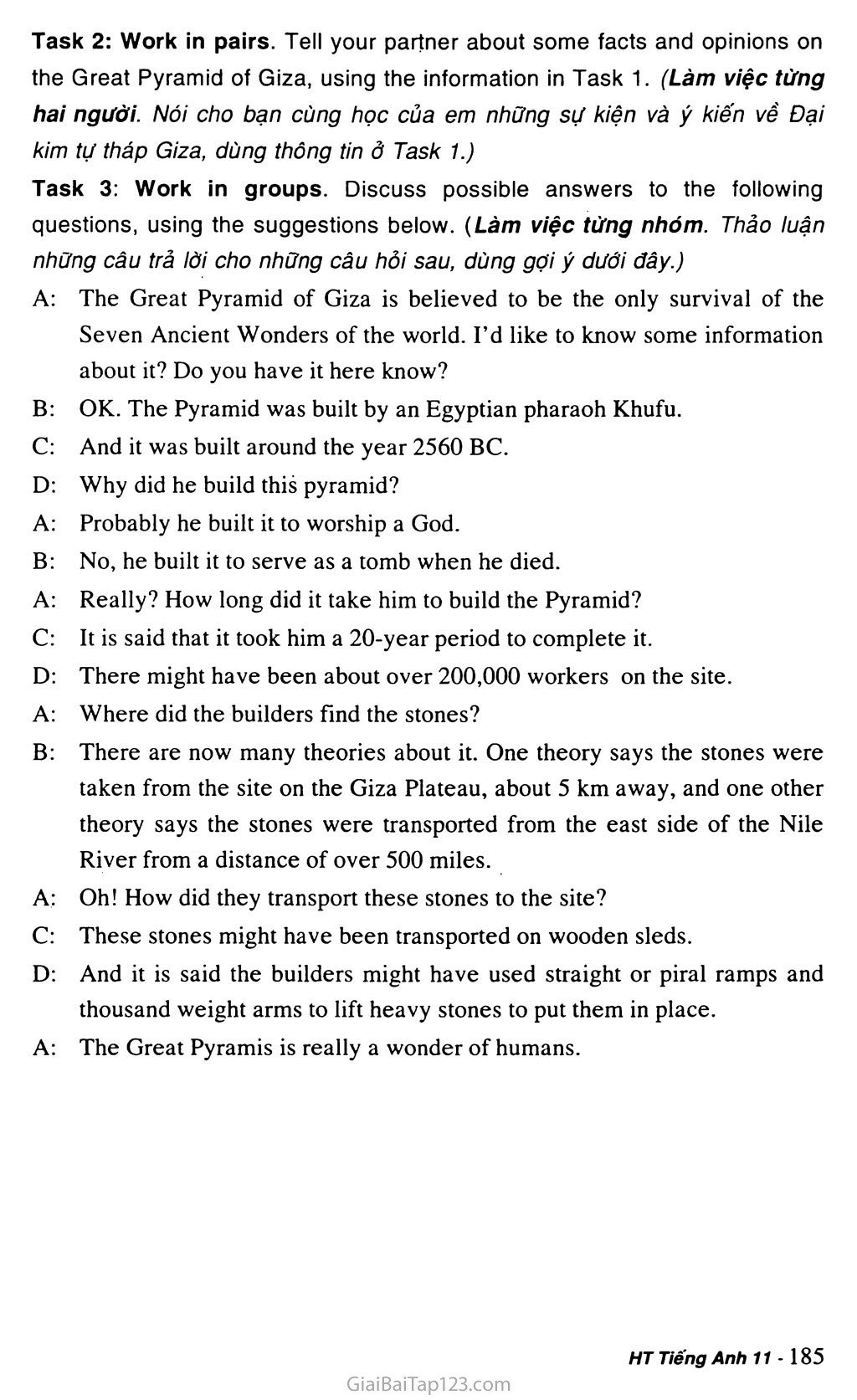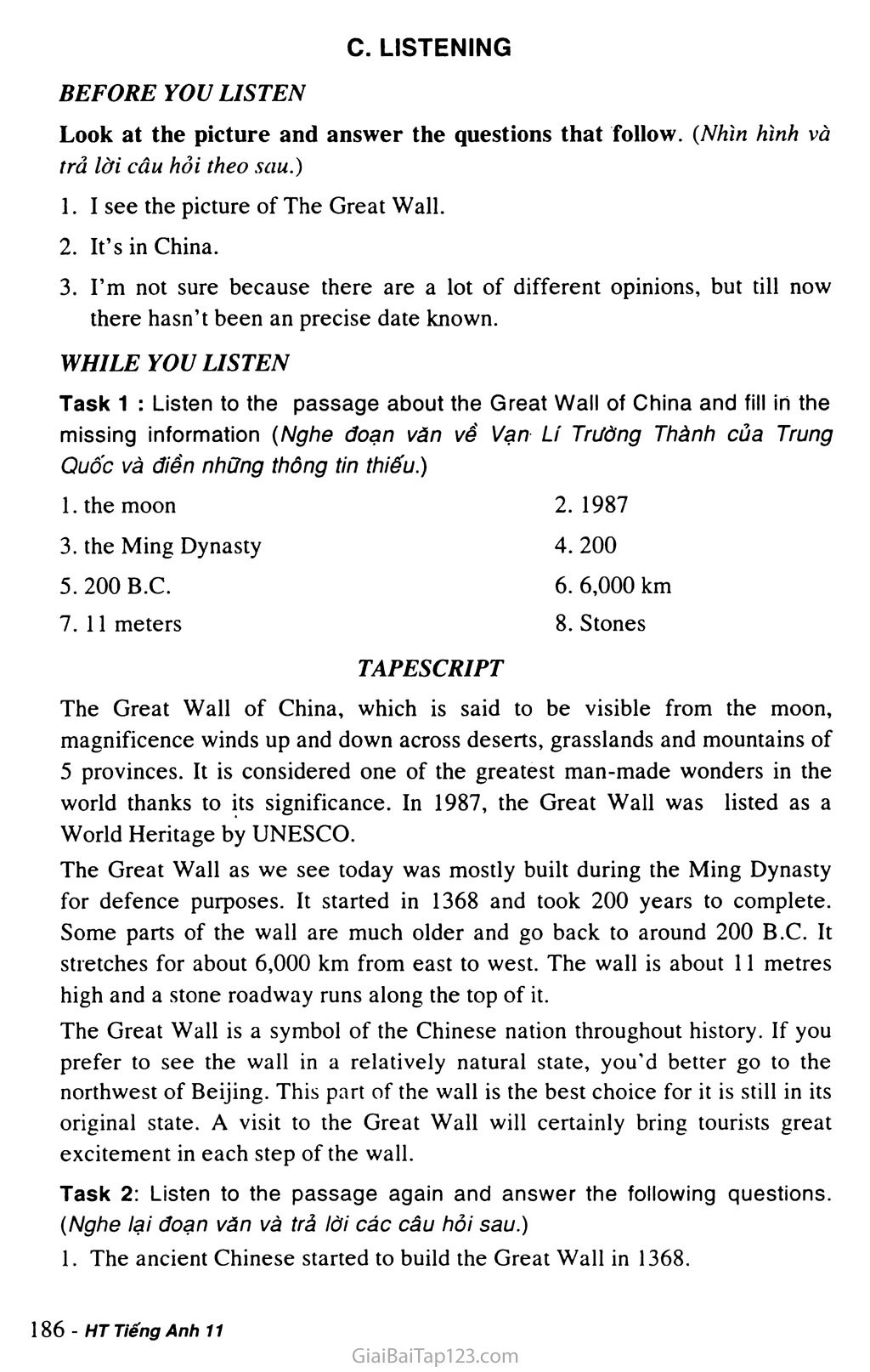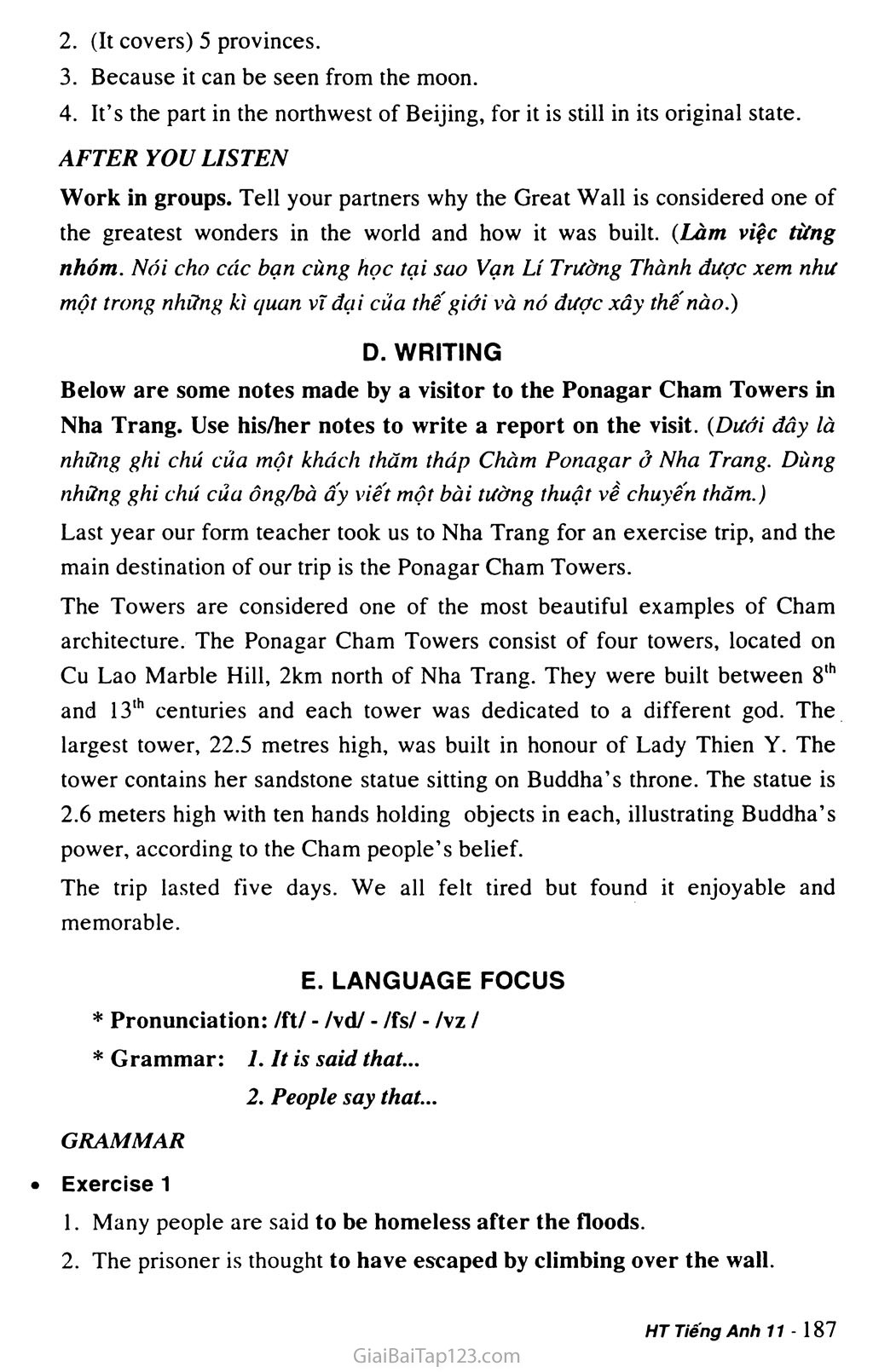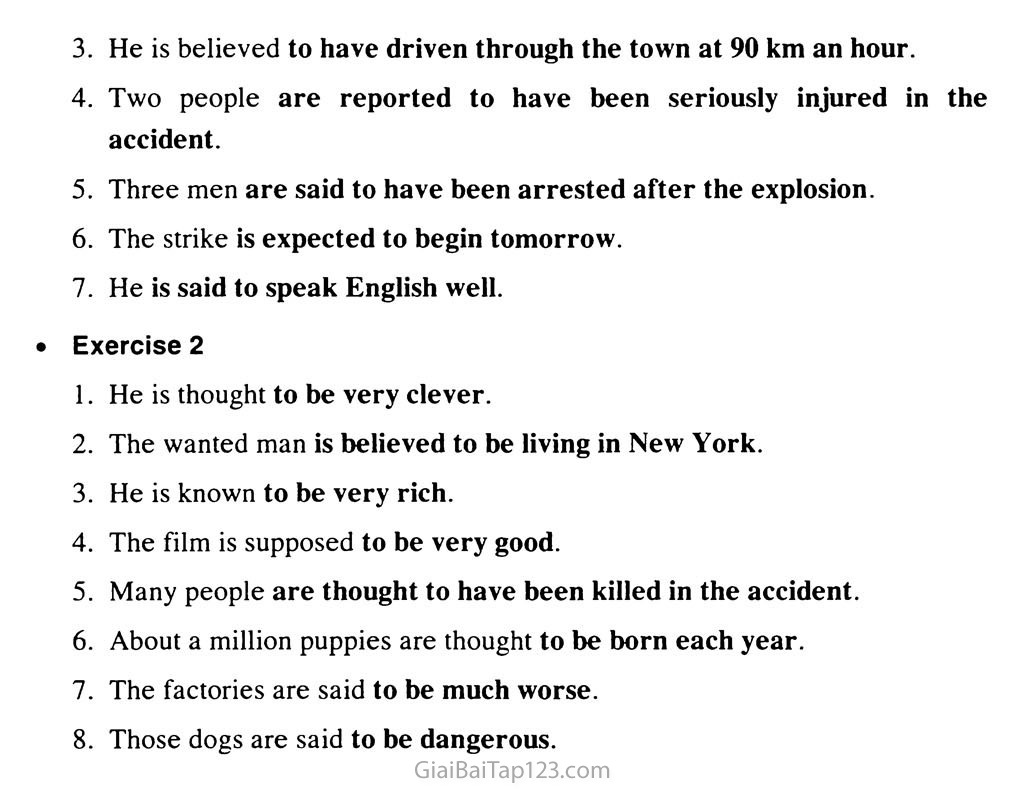Giải tiếng Anh lớp 11 Unit 16: THE WONDERS OF THE WORLD
THE WONDERS OF THE WORLD
(Các kì quan của thế giới)
VOCABULARY
man-made
[ maen meid]
(adj) : artificial: nhân tạo
natural
['naetfrl ]
(adj) : thiên nhiên, tự nhiên
burial
[‘berial]
(n) : sự chôn cất
bury
[‘ben]
(v) : chôn
chamber
[‘tfsemba}
(n) : phòng, buồng
treasure
[ltre39 ]
(n) : kho tàng, châu báu
belongings
[bi’lDnctsiqz ]
(n): possessions: của cải
base
[ beis]
(n) : nền
surpass
[S9’pa:s]
(v) : vượt, trội hcm
theory
[‘Sian]
(n) : lí thuyết
theoretical
[019’retikl]
(adj) : thuộc lí thuyết
theorize
[l0i9raiz]
(v) : lí luận
weight
[weit ]
(n) : trọng lượng
plateau
[ ‘plaetau ]
(n) : cao nguyên
mysterious
[ mistigrigs]
(adj) : huyền bí
mystery
[‘mistri]
(n) : sự/điều huyền bí, bí ẩn
ramp
[raemp ]
(n) : đường dốc
spiral
[‘spaiarl]
(adj): xoắn ốc
(n) : đường xoắn ốc
tomb
[tu:m]
(n) : mộ
mandarin
[‘maendarin]
(n) : quan lại
exit
[ ‘eksit]
(n): lối ra
/ entrance
[‘entrans]
(n) : lối vào
wheelchair
[‘widtfea]
(n): xe lăn
snail
[sneil ]
(n): ốc sên
shell
[Jel]
(n) : vỏ (ốc)
proceed
[ pra’si:d]
(v) : tiến hành
procedure
[pra’si:d3a ]
(n) : thủ tục, cách tiến hành
magnificence
[ maeg’mfisans]
(n) : vẻ tráng lệ/nguy nga
magnificent
[maag’mfisant]
(adj): nguy nga, lộng lẫy
significance
[sig’nifisans
(n) : V nghĩa
significant
[sig’mfisant ]
(adj) : đầy ý nghĩa, quan trọng
signify
[‘signifai ]
(v) : có nghĩa, có tầm quan trọng
dynasty
[‘dinasti ]
(n) : triều đại
visible
[‘vizabl ]
(adj): có thề thấy
invisible
[in’vizabl ]
(adj) : không thấy được
roadway
[‘raodwei ]
(n) : lòng đường
architecture
[‘cnkitektfa]
(n) : lối kiến trúc
marble
[ ‘ma:bl ]
(n) : cẩm thạch
dedicate to
[‘dedikeit ]
(n) : dâng tiến, cống hiến
dedication
[dedi’keifn ]
(n) : sự dâng tiến
sandstone
[‘saandstaun ]
(n) : sa thạch
throne
[Graun ]
(n) : ngai vàng, ngai
illustrate
[Tlastreit ]
(v) : minh họa
illustration
[ ila’streifn ]
(n) : sự minh họa
illustrative
[Tlastrastiv ]
(adj) ; đễ minh họa
homeless
[ ‘haomlis ]
(adj) : không nhà’, (n): những người không nhà
prisoner
[‘pnzna]
(n) : tù nhân
puppy
[‘pApi]
(n) : chó con
eternal
[ I’t3:nl]
(adj) : vĩnh cửu
eternity
[i’t3:nati ]
(n) : sự vĩnh cửu
enlist
[in’list ]
(v); đăng kí, ghi vào sổ
II. GRAMMAR
THE PASSIVE: OBJECT IS A CLAUSE (Thể bị động: Túc từ là một mệnh đề)
Trong tiếng Anh, dạng “It + be + said/believed + that..." thường được dùng trong báo chí, hay ở bài tường thuật trên tivi/truyền thanh thay cho dạng "People + say/believe + that...", và eả hai có cùng một nghĩa: ''Người ta nói/tin rằng... ”
e.g.: It is said that time is money. (Người ta nói rằng thời gian là tiền bạc.)
-*■ People say that time is money.
“It + be + said/believed (that)..." cũng được dùng cho dạng bị động của câu
với túc từ là một mệnh đề (object is a clause).
e.g.: People say (that) health is more precious than gold.
(Người ta nói sức khỏe quý hơn vàng.)
It is said that health is more precious than gold.
Health is said to be more precious than gold.
Khi túc từ là một mệnh đề, chúng ta có HAI cách đổi sang thể bị động:
Si + Vi (that) + S2 + V2 + o + M -* a. It + be + Vl (P.P.) (that) S2 + V2 + o + M.
-* b. S2 + be + Vl (P.P.) + V2 (infinitive) + o + M.
Mệnh đề chính và mệnh đề túc từ cùng thời gian (cùng thì): V2 được viết ở dạng nguyên mẫu đơn (simple infinitive).
e.g.: People believe (that) knowledge is the key to open all things.
(Người ta tin rằng kiến thức là chìa khóa mở mọi sự.)
-*■ Knowledge is believed to be the key to open all things.
Mệnh đề túc từ diễn tả hành động xảy ra trước hành động của mệnh đề chính: V2 được viềt ở dạng nguyên mẫu hoàn thành (perfect infinitive): TO HAVE + Past Participle.
Si + Vl + (that) + S2 + V2 + o + M.
-*■ S2 + be + Vl (P.P.) + to have + p.p.+ o + M.
e.g.: They know that the prisoner escaped from the jail.
(Họ biết rằng tù nhân đã vượt ngục.)
-*■ The prisoner is known to have escaped from the jail.
Mệnh đề chính và mệnh đề túc từ cùng thời gian, nhưng khác thì: V2 ở thì tiếp diễn, và VI ở thì đơn.
Sl + VI + (that) + S2 + be + V-ing + o + M.
-*• S2 + be + VI (P.P.) + to be + V-ing + o + M.
e .g.: They think that the police are searching for the murderer.
(Họ nghĩ rằng cảnh sát đang truy tìm kẻ sát nhân.)
-*■ The police are thought to be searching for the murderer.
III. SOLUTIONS AND TRANSLATIONS. (LỜI GIẢI VÀ BÀI DỊCH)
A. READING
BEFORE YOU READ
Below are two famous man-made wonders of the world. Look at them and answer the questions. {Dưới đây là hai kì quan nhân tạo nổi tiếng thê' giới. Nhìn chúng và trả lùi câu hỏi.)
These two wonders are the Great Pyramid Cheop (Khufu), and the Taj Mahal.
The Great Pyramid Cheop is in Cairo, Egypt, and the Taj Mahal in India.
They were built as tombs for their royal families. The Great Pyramid was built over 4000 years ago. And the Taj Mahal was built between 1630 and 1652 by an Indian king.
WHILE YOU READ
Read the passage and then do the tasks that follow. {Đọc đoạn văn và sau đó làm bài tập theo sau.)
ĐẠI KIM Tự THÁP GIZA
Đại Kim tự tháp Giza được xây bởi Pharaô Ai cập Khufu khoảng năm 2560 trước Công nguyên. Mục đích của Kim tự tháp bằng đá khổng lồ này là để dùng làm ngôi mộ khi ông chết và để bảo vệ phòng chôn cất khỏi thời tiết và kẻ cắp có thể cố ăn cắp kho báu và tài sản ở đây. Người ta tin Đại kim tự tháp được xây trong một thời gian hơn 20 nãm. Đầu tiên công trường được chuẩn bị và sau đó những khôi đá khổng lồ được chuyển đến và đưa vào vị trí.
Khi xây xong, Đại kim tự tháp caol47m trên một nền vuông mỗi cạnh 230m. Nó được xếp hạng như một cấu trúc cao lớn nhát trên trái đất hơn 43 thế kỉ, chỉ bị vượt qua về chiều cao vào thế kỉ 19 sau Công nguyên, cấu trúc gồm khoảng 2 triệu khôi đá, mỗi khối nặng khoảng 2 tâ'n rưỡi. Người ta đề nghị rằng có đủ những khôi đỡ ba kim tự tháp để xây một bức tường cao 3m dày 0,3 m xung quanh nước Pháp.
Mặc dù người ta không biết làm thế nào để đặt những khối đá vào vị trí, nhưng họ cũng đã đưa ra nhiều lí thuyết. Một lí thuyết bao hàm sự xây dựng một đường dóc thẳng hoặc trôn ốc được nâng cao trong lúc việc xây dựng tiến hành. Lí thuyết thứ hai cho rằng những khôi đá được nâng lên và đưa vào vị trí bằng cách dùng hàng ngàn cánh tay trọng lực khổng lồ.
Ngày nay, Đại kim tự tháp Giza được rào quanh, cùng với những kim tự tháp khác trong một vùng du lịch của Cao nguyên Giza bên bờ phía tây sông Nile. Cũng nằm trong khu vực là nhà bảo tàng chứa Con Tàu Mặt Trời huyền bí,
chỉ mới được khám phá năm 1954 gần cạnh phía nam của kim tự tháp. Con tàu được tin là đã được sử dụng để mang xác của Khufu trong chuyến du hành cuối cùng của ông trên trái đất trước khi được chôn bên trong kim tự tháp.
Task 1: The words in the box all appear in the passage. Fill each blank with asuitable word. (Tất cả từ trong khung xuất hiện ở đoạn văn. Điền môi chỗ trống với từ thích hợp.)
tomb 2. wonder 3. ramp 4. chamber 5. mysterious 6. spiral Task 2: Answer the following questions. (Trả lời các câu hỏi sau.)
It is located on the west bank of the Nile River and was built around the year 2560 BC.
It was about 147 meters high on a base of 230 meters square.
The purpose of this huge stone pyramid was to serve as a tomb when the Egyptian Pharaoh Khufu died and to protect the burial chamber from the weather and from thieves who might try to steal the treasures and belongings there.
It is thought that the ancient Egyptians used straight or spiral ramps or huge weight arms to lift and place the blocks of stone in place.
The boat is believed to have been used to carry the body of Khufu in his last journey on earth before being buried inside the pyramid.
Task 3: Scan the text and say what the following words refer to. (Đọc lướt đoạn văn và nói những từ sau chỉ gì.)
who (line 4) refers to the thieves.
it (line 8) refers to the Great Pyramid
it (line 9) refers to the Great Pyramid.
each (line 12) refers to the block of stone
AFTER YOU READ
Work in pairs. Discuss the question: Which of the wonders of the world do you prefer and why? (Làm việc từng hai người. Thảo luận câu hởi : Kì quan nào trong những kì quan thê'giới em thích hơn và tại sao?)
A: Minh, if you could visit one of the seven wonders of the world,
which one would you like to ?
Minh: Oh, if so, I would prefer to visit the Great Wall in China.
A: Why do you prefer to see it?
Minh: Because I think it has an interesting history, besides it is the longest
structure in the world.
A: What do you mean?
Minh: Well, till now no one can tell exactly when the building of the Great
Wall was started.
A: Really?
Minh: It is popularly believed that it was constructed during the earlier
Zhou Dynasty. Originally, it was the separated walls, built by other states of Qin, Yan, and Zhao kingdoms, not only one.
A: So, who made it into the present wall.
Minh: Emperor Qin Shi Huang (Tan Thuy Hoang), who ordered the
construction of the wall in 214 BC.
A; How long did it take him to finish it?
Minh: About 10 years. And one more interesting information, the present
Great Wall in Beijing is the remains from Ming Dynasty (1368-1644).
A: Sounds interesting information! Thanks for the information about
the Great Wall.
Minh: My pleasure.
B. SPEAKING
Task 1 : The sentences below all appear in the reading passage. Work in pairs. Which sentences express facts (F) and which ones, opinions (O)? Put a tick (/) in the right column. (Tất cả câu dưới đây xuất hiện ở Bài đọc. Làm việc từng hai người. Câu nào diễn tả sự kiện (F), và câu nào, ý kiến (O)? Ghi dấu (S) vào cột bên phải.)
Facts.
The Great Pyramid was 147 metres high.
The Great Pyramid is ranked as the tallest structure on earth for more than 43 centuries.
The structure consists of approximately 2 million blocks of stone.
Opinions
The Great Pyramid is believed to have been built over a 20-year period.
One theory involves the construction of a straight or spiral ramp that was raised as the construction proceeded.
A second theory suggests that the blocks were lifted and placed, using thousands of huge weight arms.
The boat is believed to have been used to carry the body of Khufu in his last journey on earth before being buried inside the pyramid.
Task 2: Work in pairs. Tell your partner about some facts and opinions on the Great Pyramid of Giza, using the information in Task 1. (Làm việc từng hai người. Nói cho bạn cùng học của em những sự kiện và ý kiến về Dại kim tự tháp Giza, dùng thông tin ở Task 1.)
Task 3: Work in groups. Discuss possible answers to the following questions, using the suggestions below. (Làm việc từng nhóm. Thảo luận những câu trả lời cho những câu hỏi sau, dùng gợi ý dưới dây.)
A: The Great Pyramid of Giza is believed to be the only survival of the Seven Ancient Wonders of the world. I’d like to know some information about it? Do you have it here know?
B: OK. The Pyramid was built by an Egyptian pharaoh Khufu.
C: And it was built around the year 2560 BC.
D: Why did he build this pyramid?
A: Probably he built it to worship a God.
B: No, he built it to serve as a tomb when he died.
A: Really? How long did it take him to build the Pyramid?
C: It is said that it took him a 20-year period to complete it.
D: There might have been about over 200,000 workers on the site.
A: Where did the builders find the stones?
B: There are now many theories about it. One theory says the stones were taken from the site on the Giza Plateau, about 5 km away, and one other theory says the stones were transported from the east side of the Nile River from a distance of over 500 miles.
A: Oh! How did they transport these stones to the site?
C: These stones might have been transported on wooden sleds.
D: And it is said the builders might have used straight or piral ramps and thousand weight arms to lift heavy stones to put them in place.
A: The Great Pyramis is really a wonder of humans.
c. LISTENING
BEFORE YOU LISTEN
Look at the picture and answer the questions that follow. (Nhìn hình và trả lời câu hỏi theo sau.)
I see the picture of The Great Wall.
It’s in China.
I’m not sure because there are a lot of different opinions, but till now there hasn’t been an precise date known.
WHILE YOU LISTEN
Task 1 : Listen to the passage about the Great Wall of China and fill in the missing information (Nghe đoạn văn về Vạn Lí Trường Thành của Trung Quốc và điền những thông tin thiếu.)
2.1987 4. 200 6. 6,000 km 8. Stones
the moon
the Ming Dynasty
5. 200 B.c.
11 meters
TAPESCRIPT
The Great Wall of China, which is said to be visible from the moon, magnificence winds up and down across deserts, grasslands and mountains of 5 provinces. It is considered one of the greatest man-made wonders in the world thanks to its significance. In 1987, the Great Wall was listed as a World Heritage by UNESCO.
The Great Wall as we see today was mostly built during the Ming Dynasty for defence purposes. It started in 1368 and took 200 years to complete. Some parts of the wall are much older and go back to around 200 B.c. It stretches for about 6,000 km from east to west. The wall is about 11 metres high and a stone roadway runs along the top of it.
The Great Wall is a symbol of the Chinese nation throughout history. If you prefer to see the wall in a relatively natural state, you'd better go to the northwest of Beijing. This part of the wall is the best choice for it is still in its original state. A visit to the Great Wall will certainly bring tourists great excitement in each step of the wall.
Task 2: Listen to the passage again and answer the following questions. (Nghe lại đoạn văn và trả lời các câu hỏi sau.)
The ancient Chinese started to build the Great Wall in 1368.
(It covers) 5 provinces.
Because it can be seen from the moon.
It’s the part in the northwest of Beijing, for it is still in its original state. AFTER YOU LISTEN
Work in groups. Tell your partners why the Great Wall is considered one of the greatest wonders in the world and how it was built. (Làm việc từng nhóm. Nói cho cức bạn cùng học tại sao Vạn Lí Trường Thành được xem như một trong những kì quan vĩ đại cửa thế giới và nó được xây thế nào.)
D. WRITING
Below are some notes made by a visitor to the Ponagar Cham Towers in Nha Trang. Use his/her notes to write a report on the visit. (Dưới đây là những ghi chú cửa một khách thăm tháp Chàm Ponagar ở Nha Trang. Dùng những ghi chú của ông/bà ấy viết một bài tường thuật về chuyến thăm.)
Last year our form teacher took US to Nha Trang for an exercise trip, and the main destination of our trip is the Ponagar Cham Towers.
The Towers are considered one of the most beautiful examples of Cham architecture. The Ponagar Cham Towers consist of four towers, located on Cu Lao Marble Hill, 2km north of Nha Trang. They were built between 8'h and 13th centuries and each tower was dedicated to a different god. The largest tower, 22.5 metres high, was built in honour of Lady Thien Y. The tower contains her sandstone statue sitting on Buddha’s throne. The statue is 2.6 meters high with ten hands holding objects in each, illustrating Buddha’s power, according to the Cham people’s belief.
The trip lasted five days. We all felt tired but found it enjoyable and memorable.
E. LANGUAGE FOCUS
Pronunciation: /ft/ - /vd/ - /fs/ - /vz /
Grammar: I. It is said that...
People say that...
GRAMMAR
• Exercise 1
Many people are said to be homeless after the floods.
The prisoner is thought to have escaped by climbing over the wall.
He is believed to have driven through the town at 90 km an hour.
Two people are reported to have been seriously injured in the accident.
Three men are said to have been arrested after the explosion.
The strike is expected to begin tomorrow.
He is said to speak English well.
• Exercise 2
He is thought to be very clever.
The wanted man is believed to be living in New York.
He is known to be very rich.
The film is supposed to be very good.
Many people are thought to have been killed in the accident.
About a million puppies are thought to be born each year.
The factories are said to be much worse.
Those dogs are said to be dangerous.

